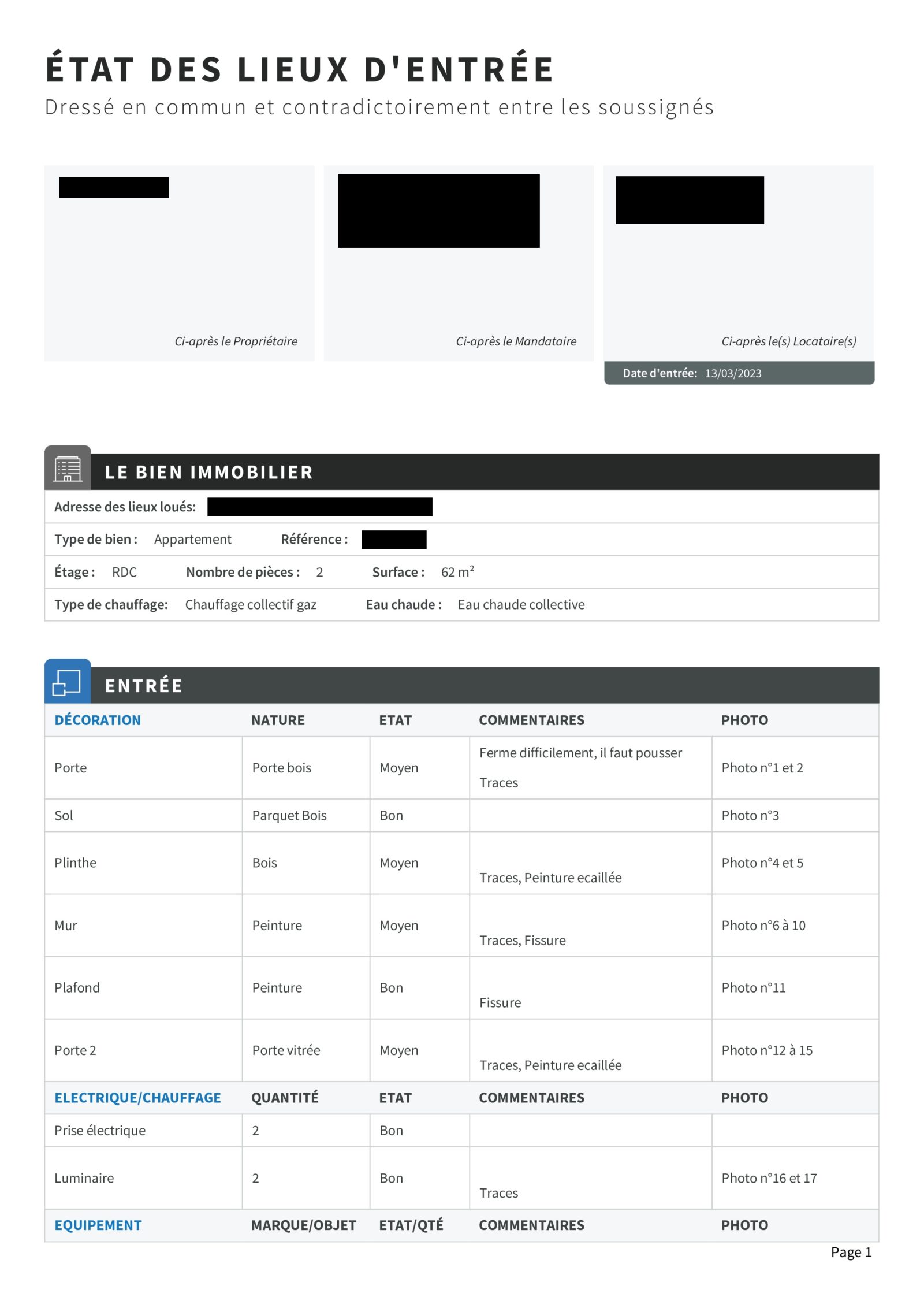When you rent out your apartment, there are a number of steps you need to follow. These include drawing up an inventory of fixtures, a key document guaranteeing the state of preservation of the apartment for both the landlord and the tenant, and which must be signed by both parties.
An inventory of fixtures is drawn up on arrival and again on departure, and a comparison between both determines the condition of the various items of furniture and equipment.
These are two essential stages in the rental of an apartment.
This article will attempt to answer a number of questions that may arise for both landlords and tenants.
So what is an inventory of fixtures: is it compulsory, what exactly should it include, and what to do in case of damage? Follow us and let’s find out!
Is an inventory of fixtures mandatory?
Yes, and that’s been the case since March 24, 2014 to be exact and for both furnished and unfurnished rentals. This is stipulated by law and is an essential step when concluding a rental contract.
Furthermore, Article 1 of the Alur law amending Article 3-2 of Law 89-462 of July 6, 1989 stipulates that an inventory of fixtures must be drawn up and attached to the contract when the keys are handed over to the tenant, and that another will be carried out when the keys are returned. The inventory must be drawn up in writing by both the tenant and the lessor (or the lessor’s representative). It must be carried out when the tenant enters the rented premises, i.e. when the keys are handed over.
The purpose of the inventory of fixtures is to protect both tenant and landlord by providing an objective state of the property and its equipment at the start of the rental period. It enables to determine whether any damage or deterioration has occurred during the rental period, and can be used as a reference when returning the security deposit.
What can be found in an inventory of fixtures?
In the context of a residential lease, the inventory of fixtures accurately describes the condition of the property and its equipment. In reality, however, there are two inventories of fixtures: one at the time of the move-in and one at the end of the rental period, when the tenant moves out.
An inventory of fixtures for a furnished rental is a document that describes the condition and inventory of the furniture and equipment in a furnished rental property. It’s an important step in concluding a furnished rental contract, both for the tenant and the landlord.
In fact, the inventory of fixtures in a furnished rental will enable you to assess the condition of the goods present in the property at the start of the rental period.
It generally includes a detailed list of :
- furniture,
- household appliances,
- accessories and other equipment supplied with the property.
Each item is described and assessed as to its condition (new, good, average, used, etc.), with any observations on existing defects or damage.
The tenant and landlord (or their representative) carry out this inventory together, inspecting the property room by room.
They must be attentive and conscientious at this stage, as the inventory will serve as a reference when the tenant leaves, to assess any further damage caused during the rental period.
It is advisable – if not essential – to take photos or videos of every item mentioned in the inventory, to provide visual evidence in the event of a dispute. Both parties must sign the inventory of fixtures to attest to its accuracy, and keep a copy.
At the end of the rental period, during the exit inventory, the owner and tenant compare the current condition of the moveable property with the one described in the initial inventory. If any damage has been found, the landlord can withhold part of the tenant’s security deposit to cover the cost of repairs.
The inventory of fixtures for furnished rentals is therefore an essential element in protecting the interests of both the tenant and the landlord, by establishing an objective record of the condition of the movable property at the beginning and at the end of the rental period.

How to draw up an inventory of fixtures?
An inventory of fixtures for a furnished rental can take the form of a written document, usually printed on paper, or in electronic form.
Here are the key elements that must be included in an inventory of fixtures for a furnished rental:
- Identity of the parties: the document must mention the names and addresses of the tenant, the owner or his representative.
- Description of the property: the property must be described in detail, including its full address, number of rooms, fixtures and fittings, etc.
- Furniture and equipment inventory: an exhaustive list of furniture, appliances and other equipment supplied with the property must be drawn up. Each item must be described in detail.
- Condition of movables: each item on the list should be assessed in terms of condition (new, good, average, used, damaged, etc.). Additional comments can be added to describe any existing defects or damage.
- Photos or videos: it is strongly recommended to take photos or videos of each item mentioned in the condition report, to provide visual evidence.
- Parties’ signatures: the tenant and landlord (or their representative) must sign the inventory of fixtures to attest to its accuracy. Each party should receive a copy of the document.
It is important that the inventory of fixtures is carried out thoroughly and objectively, accurately documenting the condition of the moveable property at the beginning and end of the rental period, to avoid any subsequent disputes.
The inventory of fixtures must be drawn up jointly and amicably according to a standard model defined by the decree of March 30, 2016, in as many copies as there are parties, dated and signed, and attached to the rental lease if the latter is signed when the keys are handed over.
Can the inventory of fixtures be completed after taking possession of the property?
If you notice that an important item has been omitted from the initial inventory of fixtures, it’s best to inform the landlord as soon as possible. The tenant can request a supplement within 10 days of completion.
It may happen that certain information was not available when the initial inventory was drawn up, or that items requiring particular attention are discovered after the fact. In such cases, it is possible to complete the initial inventory of fixtures by adding missing information or noting changes that have occurred since it was first drawn up.
It is advisable to make these additions in writing, and to have them signed by all parties concerned, to avoid any subsequent disputes. It’s also a good idea to take photographs or videos to document any changes made to the initial state.
Exit inventory and security deposit: what are the deadlines?
If the inventory of fixtures at the end of the rental matches the one carried out when the keys were handed over, the landlord or his representative will have one month to return the security deposit to the tenant. This period will be extended by a further month if the inventory of fixtures reveals any damage caused by the tenant.
Deductions corresponding to the cost of repairs will then be made from the security deposit.
What types of damage are attributable to the tenant?
We need to differentiate between damage caused by the tenant and damage caused by prolonged use of equipment or furniture. The obligations of both the tenant and the owner of the apartment are reciprocal. Article 1730 of the French Civil Code specifies the following: “If an inventory of fixtures has been drawn up between the lessor and the lessee, the latter must return the property as he received it, according to this inventory, except for what has perished or been damaged by obsolescence or force majeure”.
The tenant will therefore be responsible for any deterioration resulting from a lack of maintenance or repair when he was present in the dwelling. Any misuse or lack of maintenance of the apartment will therefore be the tenant’s responsibility. The landlord, on the other hand, will be responsible for any damage resulting from obsolescence, i.e. damage resulting from prolonged normal use of the apartment, and damage resulting from a failure to carry out repairs outside the scope of the lease.
In conclusion
Drawing up an inventory of fixtures on arrival or departure can often be a source of stress for a landlord, because, as you well know, a good inventory of fixtures is essential when renting out your apartment.
Using a management agency such as My Apartment in Paris will enable you to avoid the pitfalls of a lax inventory of fixtures. For example, we carry out the inventories of our apartments on a tablet using specialized software. This not only protects your interests, but also saves you the hassle of completing this essential step in the rental process.
Don’t hesitate to contact us via the form below if you’d like to talk to one of our team members about these issues.




